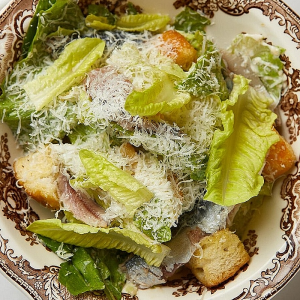Original Caesar Salad by Caesar Cardini
 Garanties sécurité
Garanties sécurité
(à modifier dans le module "Réassurance")
 Politique de livraison
Politique de livraison
(à modifier dans le module "Réassurance")
 Politique retours
Politique retours
(à modifier dans le module "Réassurance")
Original Caesar Salad by Caesar Cardini
The Caesar salad, as created in the 1920s in Tijuana, Mexico, is a simple and classic version that is the origin of the modern Caesar salad we know today. Caesar Cardini would often add a touch of freshly ground black pepper to the original Caesar salad recipe. Black pepper is essential to enhance the flavor and balance the richness of the dressing.
Here is the original recipe as Cardini prepared it:
Ingredients for the Original Caesar Salad (serves 4):
- 1 head of romaine lettuce (about 1 large head or 2 small)
- 3 slices of white bread (for croutons, cut into cubes)
- 1/2 cup grated Parmesan cheese (preferably fresh Parmesan, not powdered)
- 2 garlic cloves (for rubbing the bowl)
- 1/4 cup olive oil (extra virgin)
- 1 raw egg yolk (important for the texture of the dressing)
- 2 anchovy fillets (finely chopped or in paste form)
- 1 tablespoon Worcestershire sauce
- 1 tablespoon fresh lemon juice
- Salt and black pepper (to taste)
Preparation:
-
Preparing the croutons:
- Heat some olive oil in a pan over medium heat.
- Cut the bread slices into small cubes (croutons) and fry them until golden and crispy.
- Remove the croutons and set them aside.
-
Preparing the dressing:
- In a large bowl, rub the inside of the bowl with a garlic clove cut in half. This helps to infuse the bowl with garlic flavor.
- In the same bowl, add the raw egg yolk, chopped anchovies, Worcestershire sauce, lemon juice, salt, and pepper.
- Mix well all the ingredients. You can use a whisk to emulsify everything.
- Slowly add the olive oil while whisking constantly, until the dressing becomes creamy and well-emulsified.
-
Assembling the salad:
- Wash and dry the romaine lettuce leaves. Tear them into medium-sized pieces and place them in the large bowl with the dressing.
- Gently toss to coat the leaves with the dressing.
-
Serving:
- Add the fried croutons and grated Parmesan cheese on top of the salad.
- Toss gently or serve as is, with extra Parmesan shavings on top.
Tips:
- The original Caesar salad does not include chicken or bacon (as often seen in modern variants). It consists only of romaine lettuce, croutons, dressing, and Parmesan.
- It is important to use the raw egg yolk to achieve the creamy texture of the dressing.
Caesar Cardini's Caesar salad remains a timeless classic and is a true tribute to simplicity and bold flavors. You can enjoy it as a starter or as a light main course for lunch or dinner.
Bon appétit!
In the 1920s, Caesar salad gained popularity, and the drinks that accompanied it were often those typical of the era, especially cocktails and wines. If you were enjoying a Caesar salad at that time, here are some popular drink options:
-
Classic Cocktails of the 1920s:
- Martini: A very popular cocktail at the time, made with gin and dry vermouth. It was an elegant choice to accompany refined dishes.
- Manhattan: A cocktail made with whiskey, sweet vermouth, and a few drops of angostura bitters. Perfect for a sophisticated evening.
- Tom Collins: A light cocktail made with gin, sugar, lemon, and sparkling water. Very refreshing with light dishes like Caesar salad.
- French 75: A sparkling cocktail made with gin, champagne, sugar, and lemon. Very chic and elegant, ideal for the time.
-
Wines:
- Dry white wine: A Sauvignon Blanc or a fresh, light Chardonnay would have been an excellent choice to accompany Caesar salad, due to its acidity and freshness, which complement the richness of the cheese and dressing.
- Rosé wine: Rosé wines were also popular in the 1920s, with light and fruity flavors that pair well with the salad.
-
Non-Alcoholic Drinks:
- Sparkling water: While wine or cocktails were more common, sparkling water was also a refreshing drink option for those not consuming alcohol.
- Homemade sodas or lemonades: Though slightly more modern, sweet fruit-based drinks could also accompany light meals.
The 1920s, also known as the "Roaring Twenties," was a time of elegance and glamour, and drinks played a part in that, whether accompanying meals or served as part of social events.
In summary, you would likely have been drinking an elegant cocktail or a fine glass of wine, depending on your preferences!


